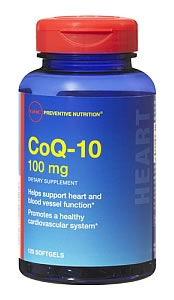| |
Vitamins pages:




|
Vitamins: CoQ10 for Heart and Cardiovascular Health
CoQ10 supplements are designed
to help maintain healthy heart and cardiovascular functions.
The energy that every cell needs to function is produced through a complex process in the
mitochondria, an organelle within the cell, often called the cellular powerhouse. Cells store energy in a molecule
called adenosine-5-triphosphate, or ATP. Thus ATP is synthesized and used by every cell in the body. CoQ10
is an essential part of the electron transport chain used to make ATP.
Cells with the highest energy demands, such as in the heart, contain the highest levels of CoQ10, which has
been studied for years in the United States, Europe, and Japan for its role in producing cellular energy for the
heart and other muscles.1 Several human clinical trials demonstrate CoQ10’s effectiveness in maintenance of
good heart function.2-5*
Antioxidant Protection
A byproduct of energy production in the mitochondria is the formation of damaging free radicals. Nature
has designed a molecule in CoQ10 that is remarkable because it not only assists in ATP production, it also
works in concert with other antioxidants to clean up the free radicals that are produced during that process
and protect against their damaging effects.6,7 As an antioxidant, it rivals vitamins E and C.8,9
In addition, CoQ10 helps to regenerate and recycle vitamin E.*
Do You Need CoQ10?
As we age, the ability to absorb and synthesize
CoQ10 diminishes and the amount of CoQ10 retained in tissues
decreases.10 In addition, CoQ10 may be depleted by several other factors, including overall nutritional status
and inadequate levels of the B vitamins, vitamin C, and selenium. Excessive exercise or environmental stresses
such as illness and extreme weather may also lower CoQ10 levels in tissue.11-13*
* These statements have not been evaluated by the Food and Drug Administration. This product is
not intended to diagnose, treat, cure, or prevent any disease.
References
1. Sarter B. J Cardiovasc Nurs 2002;16(4):9-20.
2. Langsjoen PH, Langsjoen AM. Biofactors 1999;9:273-84.
3. Soja AM, Mortensen SA. Ugeskr Laeger 1997;159:7302-08.
4. Satta A, et al. Clin Ther 1991;13:754-57.
5. Kamikawa T, et al. Am J Cardiol 1985;56:247-51.
6. Littaru GP, Battino M, Folkers K. Handbook of Antioxidants. New York: Marcel
Dekker; 1996.
7. Kagan VE, Nohl H, Quinn PJ. Handbook of Antioxidants. New York: Marcel Dekker;
1996.
8. Alleva R, et al. Mol Aspects Med 1997;81(Supp):S105-12.
9. Kontush A, et al. Biochim Biophys Acta 1995;1258:177-87.
10. Kalen A, et al. Lipids 1989;24:579-84.
11. Aberg F, et al. Eur J Clin Invest 1998;28:235-42.
12. Mortensen SA, et al. Mol Aspects Med 1997;18(Supp):S137-44.
13. Palomaki A, et al. FEBS Lett 1997;410:254-58.
|
|



No excuses! No matter where you are:
Alabama, Alaska, Arizona, Arkansas, California, Colorado, Connecticut, Delaware, Florida,
Georgia, Hawaii, Idaho, Illinois, Indiana, Iowa, Kansas, Kentucky, Louisiana, Maine,
Maryland, Massachusetts, Michigan, Minnesota, Mississippi, Missouri, Montana, Nebraska, Nevada,
New Hampshire, New Jersey, New Mexico, New York, North Carolina, North Dakota, Ohio, Oklahoma,
Oregon, Pennsylvania, Rhode Island, South Carolina, South Dakota, Tennessee, Texas, Utah,
Vermont, Virginia, Washington, West Virginia, Wisconsin, Wyoming
Get healthy in...
Boston, New York, Philadelphia, Baltimore, Washington, Richmond, Charlotte, Atlanta, Miami,
Detroit, Chicago, St. Louis, Denver, Houston, Minneapolis, Dallas, New Orleans, Mobile, Nashville,
Vancouver, Seattle, Portland, San Francisco, San Jose, Los Angeles, Phoenix, Montreal, Toronto
...and all towns in between!

|
|




